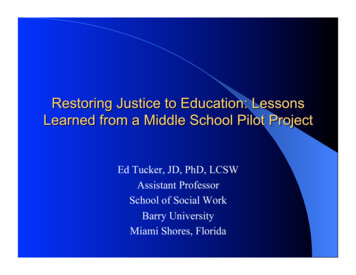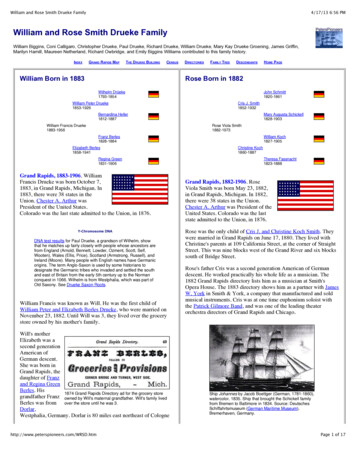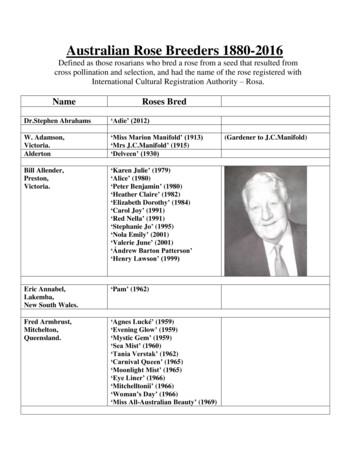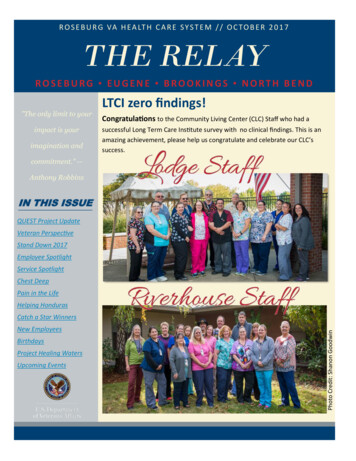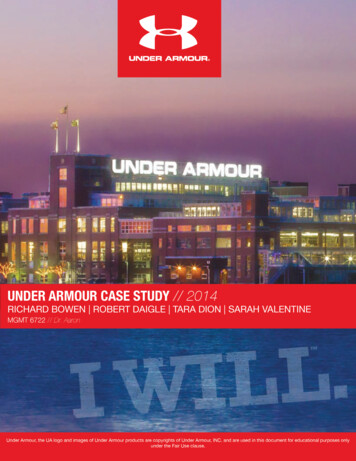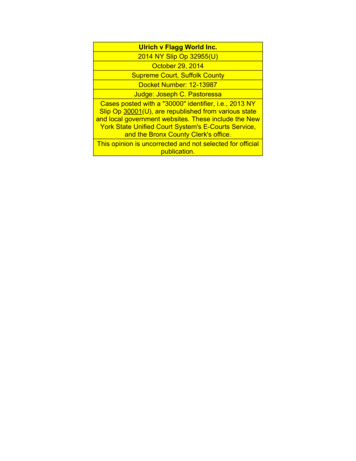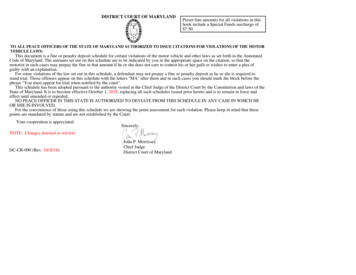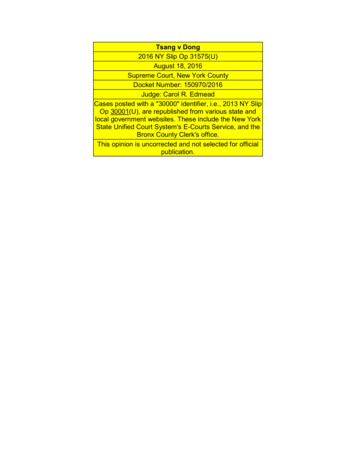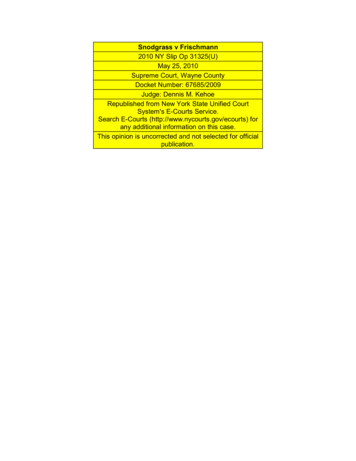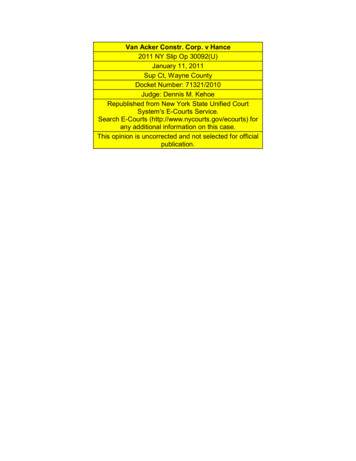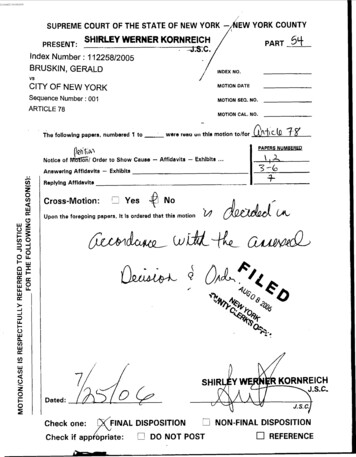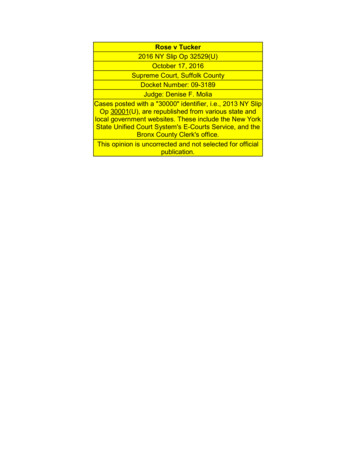
Transcription
Rose v Tucker2016 NY Slip Op 32529(U)October 17, 2016Supreme Court, Suffolk CountyDocket Number: 09-3189Judge: Denise F. MoliaCases posted with a "30000" identifier, i.e., 2013 NY SlipOp 30001(U), are republished from various state andlocal government websites. These include the New YorkState Unified Court System's E-Courts Service, and theBronx County Clerk's office.This opinion is uncorrected and not selected for officialpublication.
[* 1]SHORT FORM ORDERINDEX No.CAL. No.09-3 I 8914-02153DMSUPREME COURT - STATE OF NEW YORKI.AS. PART 39 - SUFFOLK COUNTYPRESENT:Hon. -- D E N IS E F . M O L I A - Acting Justice of the Supreme ------------------XKEVIN ROSE,Plaintiff,MOTION DATE5-22-15ADJ. DATE10-23-15Mot. Seq. # 004 MDSTANLEY E. ORZECHOWSKI, P.C.Attorney for Plaintiff38 Southern Boulevard, Suite 3Nesconset, New York 11767- against DR. MICHAEL TUCKER, D.D.S.,KAUFMAN, BORGEEST & RYAN, LLPAttorney for Defendant1205 Franklin A venue, 2nd FloorGarden City, New York ----------------------------XUpon the following papers numbered I to.12 read on this motion for summary judgment ; Notice ofMotioo/ Orderto Show Cause and supporting papers ; Notice of Cross Motion and supporting papers ; Answering Affidavits andsupporting papers 62-72 ; Replying.Affidavits and supporting papers 73-79 ; Other ; (and after hem ing eottnsel iu Sttpportand opposed to the motion) it is,ORDERED that the motion of defendant Michael Tucker, D.D.S., for, inter alia, summaryj uclgment dismissing the complaint against him is denied.Plaintiff Kevin Rose commenced this dental malpractice action against defendant MichaelTucker, D.D.S. to recover damages for injuries allegedly sustained by him as a result of negligent dentalcare and treatment and lack of informed consent. By verified bill of particulars, plaintiff alleges that Dr.Tucker's treatment rendered on July 20, 2005 through October 9, 2006 departed from acceptable dentalpractice and caused plaintiff to suffer various injuries, including a temporomandibular joint dysfunction.Specifically, plaintiff alleges that Dr. Tucker improperly shaved down four of plaintiff's front teeth,fa iled to diagnose a class III malocclusion, and failed to refer plaintiff to an orthodontist or oral surgeon.Dr. Tucker now moves for summary judgment dismissing the complaint on the grounds that histreatment of plaintiff did not depart from accepted dental practice, and that he was not the cause ofplaintiff's alleged injuries. Alternatively, Dr. Tucker seeks dismissal of the portions of the allegations ofdental malpractice based on treatment rendered prior to January 27, 2006 and other related relief. Insupport of the motion, Dr. Tucker submits copies of the pleadings, the verified bill of particulars, theTZS)
[* 2]Rose v TuckerIndex No. 09-3189transcripts of the parties· deposition testimony, plaintiffs dental records, and an affirmation of Dr.1\rnold .Jutkowitz, D.M.D.Plaintiff testified that he began treating with Dr. Tucker in 1985 for general dental care, and thatin /\ugusl 2006 he sought treatment for a tooth that he chipped while chewing. He testified that hewanted another front tooth treated for cosmetic reasons, and that he complained to Dr. Tucker severalti mes throughout the years that he was concerned about the condition of his front teeth. Ile testified thatI )r. Tucker discussed a treatment plan with him, which included bonding the front four teeth andshaving them down. I Jc testified that Dr. Tucker gave him a night guard, but he did not wear everynight. Plainti!Ttestified that Dr. Tucker shaved four of the lower front teeth and bonded two of theupper, front teeth. Plaintiff testified his father commented on the color of plaintiffs teeth being "off,''but he did not return to Dr. Tucker's office until October 2006, when he complained that his teeth weresharp and sensitive, and that he was unable to bite down with his front teeth. He testified that Dr.Tucker grinded the sharp edges with a polishing tool and told him that everything needed time to settle,but that it ''looked good." Plaintiff testified that in February 2007 he began treating with Dr. William()'Shaugnessey who examined his teeth and polished the four lower front teeth . He testified that in1\ ugust 2007, he began experiencing new complaints of clicking and iPOpping in his jaw and was w1ableto chew. 1le tes tified that he presented to Dr. Mark Slovin, who examined him and referred him to Dr.R1sa Beck. Plaintiff testified that he sought treatment from an orthodontist, Dr. Weinberg, in September2007, who told him he would need braces, but that he should consult with Dr. Beck first to treat his TMJcondition. He expiained his various treatment pians with various doctors, and testified that theyallegedly told him that his injuries were caused by the shortening of his four front teeth and a class IIImalocclusion that was not treated.Dr. Michael Tucker testified that he received his license to practice dentistry in 1973, and that1)l:1intiff became his patient on October 5, 1985. He testified from the plaintifrs dental records to thedates that plaintiff had his teeth cleaned and had x-ray pictures taken, and described the fillings plaintiffreceived throughout the years. Dr. Tucker testified that plaintiff had an ··edge to edge bite" but had nosymptoms which would cause him to recommend plaintiff to an orthodontist. i\ccording to the notesprepared by bis hygienist in July 2005, plaintiff needed a night guard, as his front teeth were beginninglo wear. I le testi lied that plaintiff returned in June 2006 for a routine examination and cleaning and thaton /\ugusl 15, 2006. plaintiff presented with a mesial incisor chip on tooth #9 and wear facets on tooth# 8. Dr. Tucker testified that he discussed the treatment plan with plaintiff, and that he bonded tooth #8and tooth 119. I le testified that he abraded the subject teeth to enable proper bonding, but that he did not.sh 1vc'" or . grind" the subject teeth. Dr. Tucker was asked about other treatment alternatives such ascrowns :1ml veneers and testified that plaintiff bad an ''edge to edge bite.'' Such occlusion, according toDr. Tucker. is not conducive ror veneers or crowns. I le explained that a veneer would not last long andthat a crown involved an unnecessarily aggressive approach which has the potential to fracture, amongother things. Dr. Tucker testified that the following day plaintiff came lo his office to pick up the nightguard. which he typically recommends for patients who grind their teeth. and that on October 9. 2006.plaintiff presented lo his office with complaints that his bottom teeth felt sharp. I Te testified that hepolished tooth #23, tooth #24, tooth # 25. tooth #26 and the back of tooth #8 , and denied shavingplaintitrs teeth down.
[* 3]Rose v J"uckcrIndex No. 09-3189Page 3orlt is well settled that a party moving for summary judgment must make a prima facie showingentitlement to judgment as a matter of law, tendering sufficient evidence to eliminate any material issueof !'act (see A lvarez v Prospect Hosp. , 68 NY2d 320, 508 NYS2d 923 [1986]; Friends ofA nimals v, lssociated Fu r /'Vlfrs . 46 NY2d I 065. I 067, 416 NYS2d 790 (19791). The failure of the moving partyLo make a prima focie showing requires the denial of the motion regardless of the sufficiency of theopposing papers (see Willegrad v New York Uuiv. Med. Ctr. , 64 NY2d 851, 487 NYS2 l 316 r1985 ]).The burden then shifts to the party opposing the motion which must produce cvidentiary proof inadmissible form sufficient to require a trial of the material issues of fact (Zuckerman v City of NewYorlL 49 NY2d 557. 427 J YS2d 595 119801. The cowi's functio n is to detem1ine w hether issues of factexist not lo resolve issues of fac t or to determine matters of credibility; therefore, in dctennining themotion for summary judgment, the facts alleged by the opposing party and all inferences that may bedrawn are to be accepted as true (see Roth v Barreto, 289 AD2d 557,, 735 NYS2d 197 r200J"j ; O'Neill vFisl!lii/I, 134 /\D2d 487, 521 NYS2d 272 [ 1987]).Th requisite elements of proof in a medical or dental malpractice action are a deviation ordeparture from accepted standards of dental practice, and evidence that such departure was a proximatecause of the plaintiff's injuries (see Liyanage v A ma1111, 128 AD3d 645, 8 NYS3d 390 [2d Dept 2015];Clum v Toothsavers Dental Care, Inc. , 125 AD3d 712, 4 NYS3d 59 (2d Dept 2015); Kozlowski vOa11a, 102 A03d 751, 959 NYS2d 500 [2d Dept 2013]; Zito v Jastremski, 58 AD3d 724, 871 NYS2d717 l2d Dept 2009]). A defendant seeking summary judgment on a dental malpractice claim has theinitiai burden of estabiishing that the treatment he or she rendered did not deviate from good andaccepted dental practice, or that the plaintiff was not injured by such treatment (McGuiga11 vCe11tereac'1 Mgt. Group, Inc., 94 /\DJd 955, 942 NYS2d 558 [2d Dept 2012); Sharp v Weber, 771\ D3d 812, 909 NYS2d 152 (2d Dept 201 O]; Stukas v Streiter, 83 AD3d 18, 9 18 NYS2d 176 (2d Dept2011 ]). To satisfy his or her burden, a defendant dentist must establish through medical records andexpert affidavits that he or she did not depart from accepted dental practice in the treatment of theplaintiff (Koi llou C'1a11 v Yeung, GG AD3d 642, 887 NYS2d 164 [2d Dept 2009]; Jones v Ricciardelli.40 J\D3d 935, 836 NYS2d 879 f2d Dept 2007]). Once demonstrated, the burden shifts to plaintiff todemonstrate the existence of a triable issue of fact by submitting an expert's affidavit or affirmationattesting to a departure from accepted dental practice and opining that the defendant's acts or omissionswere a competent producing cause of the plaintifrs injuries (see Landry v J"kubowitz. 68 AD3d 728, : 89 NYS2d 677 [2d Dept 20091; Luu v Paskowski, 57 J\D3d 856, 871 NYS2d 227 [2d Dept 2008 1).I ll:rc. dclcndant submits the affirmation of Arnold Jutkowitz. D.M.D. a licensed dentist in theState of New York. Dr. Jutkowilz states that he has been in practice since I 970 and has extensiveexperience in cosmetic and restorative dentistry. He states that he has reviewed the bill or particulars,the transcripts the parties· deposition testimony. plaintiffs dental records. and a report from Dr. /\IanKucinc. who performed an independent dental examination on plaintiff. Dr . .Tutkowitz opines, with areasonable degree of dental certainty that Dr. Tucker acted in accordance with acceptable dentalstandards and his treatment or plaintiff was not a cause of his injuries. Dr. Jutkowitz states that heri.:vie\\ eel the :x-ray imagesplaintiffs teeth and opines that the height of plaintiff's teeth never changedo \ er hi!' course o f treatments with Dr. Tucker. l le opines that Dr. Tucker did not shave or grind thesubject teeth. Dr. Jutkowitz opines that plaintiff's .edge to edge bite,·· while less aesthetic, is notoror
[* 4]Rose v TuckerIndex No. 09-3189Page 4p tthol o gical and docs not have lo be changed. He opines that it is common for people lo have class lllocclusions and they are not considered abnonnnl and do not require a rcfonal to an orthodontist.According to Dr. Jutkowitz, there was no evidence that plaintiffs occlusion was causing plaintiff anycomplaints other than wear and tear which Dr. Tucker properly addressed with the bonding procedure.Dr. Jukowitz extensively details the proof that forms the basis of his opinion that Dr. Tucker onlypolished plaintifrs lower front four teeth and did not shave or grind them. Further, he opines thatplaintiff's alleged injuries were caused by a history of bruxism, for which the night guard wasprescribed, but plaintiff failed to wear it. He opines that Dr. Tucker properly monitored plaintiff's teeth,;md that his treatment or plaintiff did not depart from acceptable dental practice and was not a cause ofpl;1i nti rr s injuries.Dr. Tucker established, prima facie, his entitlement to summary judgment dismissing thecomplaint against him by proffering, among other things, the affirmation of Dr. Jutkowitz, who opinesthat Dr. Tucker's treatment of plaintiff was in accordance with medically accepted standards of dentalpractice, that such treatment did not constitute a departure from same, and was not a proximate cause ofplaintiffs alleged injuries (Garcia v Rieber, 132 AD3d 809, 18 NYSJd 401 [2d Dept 2015)). Theburden, therefore, shifted to plaintiff to raise a triable issue of fact (see A lvarez v Prospect Hosp., 68NY2d 320, 508 NYS2d 923; Stukas v Streiter, 83 AD3d 18, 918 NYS2d l 76.In opposition to the motion, plaintiff submits, among other things, the affidavit of LeonardGokbi .:i11, D.D.S. in his affi lavii, Dr. Goidsiein states that he is iicensed to practice dentistry in theState of New York since 1967. He states that he has reviewed plaintiffs dental records, discoverymaterials and transcripts of the deposition testimony given by plaintiff and defendant, and the report ofthe independent examination conducted by Dr. Alan Kucine. He opines, with a reasonable degree ofdental certainty, that the care and treatment rendered to plaintiff by Dr. Tucker departed from acceptabledental practice and was a proximate cause of plaintitrs i1 uries. Dr. Goldstein opines that plaintiff's··edge to edge bite" is considered a Class III malocclusion and "clear pathology" that Dr. Tucker failed to t ppreciate and properly reCer to an orthodontist. lle opines that plaintiffs injuries were caused by thesha ving, grinding and reduction of tooth #23 , tooth #24, tooth #25, tooth# 26. Ile states that he reviewedthe x-ray images or plaintiff's teeth and disagrees with delcndanl's expert regarding their height. Heopines that the various x-ray images do dcmonstrntc a change in height. Dr. Goldstein opines that anight guard would not have prevented plaintiff's teeth from suffering from wear and tear as it would notprevent the wear and tear during the daytime, and the acceptable standard of dental care was for Dr.Tucker to rclcr plaintiff to .111 orthodontist, among other things.The affirmation of plaintitrs expert, Dr. Goldstein, is sufficient to raise triable issues of fact as towhctlwr Dr. Tucker brcachc.:: l the duty of care owed lo plaintiff by depaiiing from acceptable dentalpr:td icc and \),'hcthcr such departure was a cause of plaintiffs injuries. Jn a medical malpractice action.conl1icting expert opinions require denial of a summary judgment motion (Leto v Feld. I 3 1 AD3d 590.15 NYS3d 208 l2d Dept 2015]; McKenzie v Clarke. 77 /\D3d 637. 908 NYS2d 370 [2d Dept 20 IO]).Such issues of credibility are properly determined by the trier fact (Wexe/baum v Jean , 80 /\DJd 756.915NYS2d161 f2 lDcpt201ll).or
[* 5]Rt)sc \' TuckerIndex i'\o. 09-3189Page 5With respect to the cause of action for lack of informed consent. the e lements arc "(l) that theperson providing the professional treatment failed to disclose alternatives thereto and failed to inform thepatient or reasonably foreseeable risks asocited with the treatment, and the alternatives, that a reasonablemedical practitioner would have disclosed n the same circustances, (2) that a reasonably prudent patientin the same position would not have unergone the treatment if he or she had been fully informed, and (3)1ha1 lh.: lack of informed consent is a proximate cause or the injury" (Spano v Bertocci, 299 AD2d 335.337-338. 749 NYS2d 275 l2d Dept 2002]). for the claim to be actionable, the defendant must haveengaged in a "non-emergency treatment, procedure o surgery" or" diagnostic procedure which involvedinvasion or disruption of the integrity of the body" ( Public Health Law§ 2805-d 121). Furthcm1ore. anessential element of a cause of action for lack of informed consent is tat there be an affirmative violationof the plaintiffs physical integrity (Ellis v Eng,, 70 AD3d 88, 895 NYS2d 462 r2d Dept 2010]). Here,the evidence presents triable issues of fact as to whether Dr. Tucker shaved plaintiff's teeth or merelypolished them. Accordingly, the application for summary judgment dismissing the complaint is denied.T he branches of the motion which seek partial summary judgment pursuant to CPLR 214-adismissing plaintiff's claims of malpractice for treatment rendered to plaintiff prior to July 27, 2006 onthe ground that it is time barred and other related relief are denied. Generally, a cause of action allegingdental malpractice accrues on the date of the alleged wrongful act or omission, and the statute oflimitations begins running on that date (Leifer v Parikh , 292 AD2d 426, 739 NYS2d 415 [2d Dept2002]). CPLR 214-a prescribes that an action for medical, dental or podiatric malpractice "must becommenced within two years and six months of the act, omission or faiiure compiained or iast treatmentwhere there is continuous treatment for the same illness, injury or condition which gave rise to the saidact, omission or failure." Where a patient is undergoing a "continuous course of treatment'' with thephysician with respect to the same condition or complaint that gives rise to the lawsuit, the statute oflimitations wil l not begin to run until the end of the course of treatment (see Nykorcl111ck v lle11riques,78 NY2d 255. 573 NYS2d 434 l 1991 ]: Fraumeni v Oakwood Dentlll Arts, LLC, 108 AD3d 495, 968NYS2d56112d Dept2013]).Here, plainti lrs last date of treatment with Dr. Tucker was on October 9, 2006 and this actionwas commenced on January 27, 2009. Dr. Tucker argues that any treatment rendered prior to July 27.2006 is time barred and docs not fall within the continuous course of treatment exception as thetreatment was merely for routine examinations and cleaning. However, due to the conflicting testimonyof plainti IT und Dr. Tucker as to the nature and context of the treatments, the court cannot conclude as a11 1:1\lcr of law that they represent continuo us treatment within the meaning of CPLR 214-a, so as to tollthe statute or limitations (Z;to v Jastremski, 58 AD3d 724. 871 NYS2cl 717 f2d Dept 20091).Dated:JV- 171--lb- FINAL DISPOSITIONHa DrY i·f iaA.J.S.C.NON-FINAL DISPOSITION
drawn are to be accepted as true (see Roth v Barreto, 289 AD2d 557,, 735 NYS2d 197 r200J"j; O'Neill v Fisl!lii/I, 134 /\D2d 487, 521 NYS2d 272 [ 1987]). Th requisite elements of proof in a medical or dental malpractice action are a deviation or departure from accepted standards of dental p
